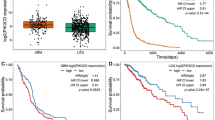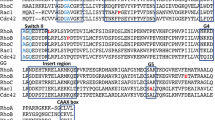Abstract
Glioblastoma multiforme is the most aggressive form of primary brain tumor and remains largely incurable, in large part, due to its highly invasive nature. The phosphoinositide (PI) 3-kinase pathway is often constitutively active in these tumors due to activating mutations in the epidermal growth factor receptor, or deletion/loss of function of the tumor suppressor PTEN. Protein kinase C type ι (PKCι), a member of the atypical protein kinase C family, is activated by the PI 3-kinase pathway and is an important downstream mediator. Here, we have assessed the role of PKCι in glioblastoma cell invasion. Depletion of PKCι with RNA interference caused an increase in actin stress fibers and a decrease in cell motility and invasion. Gene expression microarray analysis of U87MG cells showed that PKCι repressed expression of mRNA for RhoB, which has previously been shown to have a role in actin stress fiber formation. Western blot analysis showed that both PKCι depletion and pharmacological inhibition of PKCι caused an increase in the protein levels of RhoB, as did inhibition of PI 3-kinase. Expression of RhoB from a constitutive promoter caused changes in actin stress fibers and cell invasion that were similar to those seen with PKCι depletion. These data show that PKCι, activated as a consequence of aberrant upstream PI 3-kinase signaling, mediates glioblastoma cell motility and invasion, and that repression of RhoB is key downstream event in PKCι signaling leading to enhanced cell motility. In addition, constitutive expression of RhoB repressed PKCι activity, as assessed by its phosphorylation status on Thr555. PKCι and RhoB are, therefore, mutually antagonistic, potentially creating a sensitive switch between invasive and non-invasive phenotypes.
This is a preview of subscription content, access via your institution
Access options
Subscribe to this journal
Receive 50 print issues and online access
$259.00 per year
only $5.18 per issue
Buy this article
- Purchase on Springer Link
- Instant access to full article PDF
Prices may be subject to local taxes which are calculated during checkout





Similar content being viewed by others
References
Akimoto K, Takahashi R, Moriya S, Nishioka N, Takayanagi J, Kimura K et al. (1996). EGF or PDGF receptors activate atypical PKClambda through phosphatidylinositol 3-kinase. EMBO J 15: 788–798.
Baldwin RM, Garratt-Lalonde M, Parolin DA, Krzyzanowski PM, Andrade MA, Lorimer IA . (2006). Protection of glioblastoma cells from cisplatin cytotoxicity via protein kinase Ciota-mediated attenuation of p38 MAP kinase signaling. Oncogene 25: 2909–2919.
Bellail AC, Hunter SB, Brat DJ, Tan C, Van Meir EG . (2004). Microregional extracellular matrix heterogeneity in brain modulates glioma cell invasion. Int J Biochem Cell Biol 36: 1046–1069.
Cai XM, Tao BB, Wang LY, Liang YL, Jin JW, Yang Y et al. (2005). Protein phosphatase activity of PTEN inhibited the invasion of glioma cells with epidermal growth factor receptor mutation type III expression. Int J Cancer 117: 905–912.
Coghlan MP, Chou MM, Carpenter CL . (2000). Atypical protein kinases Clambda and -zeta associate with the GTP-binding protein Cdc42 and mediate stress fiber loss. Mol Cell Biol 20: 2880–2889.
Eder AM, Sui X, Rosen DG, Nolden LK, Cheng KW, Lahad JP et al. (2005). Atypical PKCiota contributes to poor prognosis through loss of apical-basal polarity and cyclin E overexpression in ovarian cancer. Proc Natl Acad Sci USA 102: 12519–12524.
Etienne-Manneville S, Manneville JB, Nicholls S, Ferenczi MA, Hall A . (2005). Cdc42 and Par6-PKCzeta regulate the spatially localized association of Dlg1 and APC to control cell polarization. J Cell Biol 170: 895–901.
Flynn P, Mellor H, Casamassima A, Parker PJ . (2000). Rho GTPase control of protein kinase C-related protein kinase activation by 3-phosphoinositide-dependent protein kinase. J Biol Chem 275: 11064–11070.
Forget MA, Desrosiers RR, Del M, Moumdjian R, Shedid D, Berthelet F et al. (2002). The expression of rho proteins decreases with human brain tumor progression: potential tumor markers. Clin Exp Metastasis 19: 9–15.
Fritz G, Kaina B, Aktories K . (1995). The ras-related small GTP-binding protein RhoB is immediate-early inducible by DNA damaging treatments. J Biol Chem 270: 25172–25177.
Gampel A, Parker PJ, Mellor H . (1999). Regulation of epidermal growth factor receptor traffic by the small GTPase rhoB. Curr Biol 9: 955–958.
Gardner TS, Cantor CR, Collins JJ . (2000). Construction of a genetic toggle switch in Escherichia coli. Nature 403: 339–342.
Gerhard R, Tatge H, Genth H, Thum T, Borlak J, Fritz G et al. (2005). Clostridium difficile toxin A induces expression of the stress-induced early gene product RhoB. J Biol Chem 280: 1499–1505.
Giese A, Bjerkvig R, Berens ME, Westphal M . (2003). Cost of migration: invasion of malignant gliomas and implications for treatment. J Clin Oncol 21: 1624–1636.
Gustafson WC, Ray S, Jamieson L, Thompson EA, Brasier AR, Fields AP . (2004). Bcr-Abl regulates protein kinase Ciota (PKCiota) transcription via an Elk1 site in the PKCiota promoter. J Biol Chem 279: 9400–9408.
Huang M, Prendergast GC . (2006). RhoB in cancer suppression. Histol Histopathol 21: 213–218.
Ishii N, Maier D, Merlo A, Tada M, Sawamura Y, Diserens AC et al. (1999). Frequent co-alterations of TP53, p16/CDKN2A, p14ARF, PTEN tumor suppressor genes in human glioma cell lines. Brain Pathol 9: 469–479.
Jiang K, Sun J, Cheng J, Djeu JY, Wei S, Sebti S . (2004). Akt mediates Ras downregulation of RhoB, a suppressor of transformation, invasion, and metastasis. Mol Cell Biol 24: 5565–5576.
Jin Z, Xin M, Deng X . (2005). Survival function of protein kinase C{iota} as a novel nitrosamine 4-(methylnitrosamino)-1-(3-pyridyl)-1-butanone-activated bad kinase. J Biol Chem 280: 16045–16052.
Kanzaki M, Mora S, Hwang JB, Saltiel AR, Pessin JE . (2004). Atypical protein kinase C (PKCzeta/lambda) is a convergent downstream target of the insulin-stimulated phosphatidylinositol 3-kinase and TC10 signaling pathways. J Cell Biol 164: 279–290.
Lambrechts A, Van Troys M, Ampe C . (2004). The actin cytoskeleton in normal and pathological cell motility. Int J Biochem Cell Biol 36: 1890–1909.
Lavictoire SJ, Parolin DA, Klimowicz AC, Kelly JF, Lorimer IA . (2003). Interaction of Hsp90 with the nascent form of the mutant epidermal growth factor receptor EGFRvIII. J Biol Chem 278: 5292–5299.
Liu A, Prendergast GC . (2000). Geranylgeranylated RhoB is sufficient to mediate tissue-specific suppression of Akt kinase activity by farnesyltransferase inhibitors. FEBS Lett 481: 205–208.
Losa JH, Parada CC, Viniegra JG, Sanchez-Arevalo Lobo VJ, Cajal S, Sanchez-Prieto R . (2003). Role of the p38 MAPK pathway in cisplatin-based therapy. Oncogene 22: 3998–4006.
Messerschmidt A, Macieira S, Velarde M, Badeker M, Benda C, Jestel A et al. (2005). Crystal structure of the catalytic domain of human atypical protein kinase C-iota reveals interaction mode of phosphorylation site in turn motif. J Mol Biol 352: 918–931.
Newton AC . (2003). Regulation of the ABC kinases by phosphorylation: protein kinase C as a paradigm. Biochem J 370: 361–371.
Ohgaki H, Kleihues P . (2007). Genetic pathways to primary and secondary glioblastoma. Am J Pathol 170: 1445–1453.
Regala RP, Weems C, Jamieson L, Copland JA, Thompson EA, Fields AP . (2005a). Atypical protein kinase Ciota plays a critical role in human lung cancer cell growth and tumorigenicity. J Biol Chem 280: 31109–31115.
Regala RP, Weems C, Jamieson L, Khoor A, Edell ES, Lohse CM et al. (2005b). Atypical protein kinase C iota is an oncogene in human non-small cell lung cancer. Cancer Res 65: 8905–8911.
Sang RL, Johnson JF, Taves J, Nguyen C, Wallert MA, Provost JJ . (2007). Alpha(1)-adrenergic receptor stimulation of cell motility requires phospholipase D-mediated extracellular signal-regulated kinase activation. Chem Biol Drug Des 69: 240–250.
Selbie LA, Schmitz-Peiffer C, Sheng Y, Biden TJ . (1993). Molecular cloning and characterization of PKC iota, an atypical isoform of protein kinase C derived from insulin-secreting cells. J Biol Chem 268: 24296–24302.
Soloff RS, Katayama C, Lin MY, Feramisco JR, Hedrick SM . (2004). Targeted deletion of protein kinase C lambda reveals a distribution of functions between the two atypical protein kinase C isoforms. J Immunol 173: 3250–3260.
Tamura M, Gu J, Takino T, Yamada KM . (1999). Tumor suppressor PTEN inhibition of cell invasion, migration, and growth: differential involvement of focal adhesion kinase and p130Cas. Cancer Res 59: 442–449.
Uberall F, Hellbert K, Kampfer S, Maly K, Villunger A, Spitaler M et al. (1999). Evidence that atypical protein kinase C-lambda and atypical protein kinase C-zeta participate in Ras-mediated reorganization of the F-actin cytoskeleton. J Cell Biol 144: 413–425.
Wheeler AP, Ridley AJ . (2004). Why three Rho proteins? RhoA, RhoB, RhoC, and cell motility. Exp Cell Res 301: 43–49.
Xu L, Deng X . (2006). Protein kinase Ciota promotes nicotine-induced migration and invasion of cancer cells via phosphorylation of micro- and m-calpains. J Biol Chem 281: 4457–4466.
Zhang L, Huang J, Yang N, Liang S, Barchetti A, Giannakakis A et al. (2006). Integrative genomic analysis of protein kinase C (PKC) family identifies PKCiota as a biomarker and potential oncogene in ovarian carcinoma. Cancer Res 66: 4627–4635.
Acknowledgements
This work was supported by grants from the Canadian Cancer Society and the Canadian Institutes of Health Research (to IAJL). RMB is a research student of The Terry Fox Foundation through an award from the National Cancer Institute of Canada.
Author information
Authors and Affiliations
Corresponding author
Additional information
Supplementary Information accompanies the paper on the Oncogene website (http://www.nature.com/onc).
Rights and permissions
About this article
Cite this article
Baldwin, R., Parolin, D. & Lorimer, I. Regulation of glioblastoma cell invasion by PKCι and RhoB. Oncogene 27, 3587–3595 (2008). https://doi.org/10.1038/sj.onc.1211027
Received:
Revised:
Accepted:
Published:
Issue Date:
DOI: https://doi.org/10.1038/sj.onc.1211027
Keywords
This article is cited by
-
From signalling pathways to targeted therapies: unravelling glioblastoma’s secrets and harnessing two decades of progress
Signal Transduction and Targeted Therapy (2023)
-
Protein kinase C and cancer: what we know and what we do not
Oncogene (2014)
-
Repression of cancer cell senescence by PKCι
Oncogene (2012)
-
Rac and Rho GTPases in cancer cell motility control
Cell Communication and Signaling (2010)
-
Coordination of glioblastoma cell motility by PKCι
Molecular Cancer (2010)



